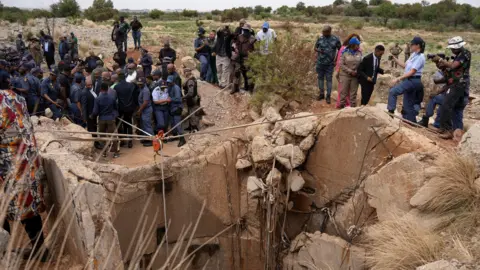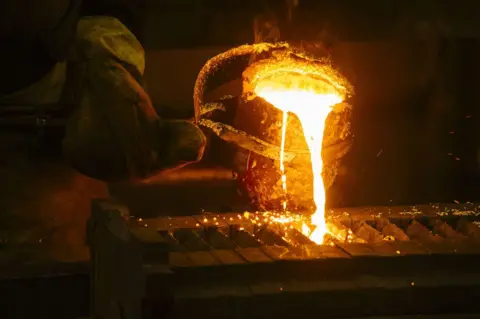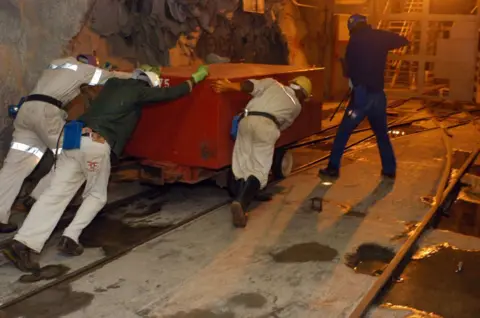 Getty Images
Getty ImagesAlong with about 600 other men, Ndumiso lives and works in a small gang-controlled “town” – complete with markets and a red light district – that has grown up deep underground at a disused gold mine in South Africa.
Ndumiso told the BBC that after being laid off by a big mining firm, he decided to join the gang in its underground world to become what is known as a “zama zama”, an illegal miner.
He digs for the precious metal and surfaces every three months or so to sell it on the black market for a huge profit, earning more than he ever did before – though the risks now are far higher.
“The underground life is ruthless. Many do not make it out alive,” said the 52-year-old, who spoke to the BBC on condition that his real name was not used as he feared reprisals.
“In one level of the shaft there are bodies and skeletons. We call that the zama-zama graveyard,” he said.
But for those who survive, like Ndumiso, the job can be lucrative.
While he sleeps on sandbags after back-breaking days underground, his family lives in a house he has bought in a township of the main city, Johannesburg.
He made cash payments of 130,000 rand (about $7,000; £5,600) for the one-bedroom house, which he has now extended to include another three bedrooms, he said.
An illegal miner for about eight years, Ndumiso has managed to send his three children to fee-paying schools – one of whom is now in university.
“I have to provide for my wife and children and this is the only way I know,” he said, adding that he preferred to toil underground rather than adding to the high crime rate by becoming a car-hijacker or robber, after spending many years trying to find legal work.
His current job is at a mine in the small town of Stilfontein, around 90 miles (145km) south-west of Johannesburg, which is at the centre of global attention after a government minister, Khumbudzo Ntshavheni, promised to “smoke out” the hundreds of miners who were underground there, with the security forces preventing food and water from being sent down.
“Criminals are not to be helped. Criminals are to be persecuted,” Ntshavheni said.
A campaign group, The Society for the Protection of Our Constitution, has launched a court case to demand access to the mineshaft, which police say is about 2km (1.2 miles) deep.
The court has given an interim ruling, stating that food and other essentials could be delivered to the miners.
 Reuters
ReutersNdumiso works at a different shaft at the mine, and surfaced last month, before the current stand-off.
He is now waiting to see how the situation unfolds, before deciding whether to return.
The stand-off follows a government decision to crack down on an industry that has spiralled out of control, with mafia-like gangs running it.
“The country has been grappling with the scourge of illegal mining for many years, and mining communities bore the brunt of peripheral criminal activities such as rape, robbing and damage to public infrastructure, among others,” said Mikateko Mahlaule, chairman of the parliamentary committee on mineral resources.
South Africa’s President Cyril Ramaphosa said the mine was a “crime scene”, but police were negotiating with the miners to end the stand-off, rather than going down to arrest them.
“Law-enforcement authorities have information that some of the miners may be heavily armed. It is well-established that illegal miners are recruited by criminal gangs and form part of wider organised crime syndicates,” he added.
Ndumiso was among hundreds of thousands of workers – both locals and nationals of neighbouring states like Lesotho – who have been retrenched as South Africa’s mining industry has gone into decline over the last three decades. Many of these have gone on to become “zama zamas” at the abandoned mines.
South Africa-based Benchmark Foundation researcher David van Wyk, who has studied the industry, said there were about 6,000 abandoned mines in the country.
“While they are not profitable for large-scale industrial mining, they are profitable for small-scaling mining,” he told the BBC Focus on Africa podcast.
Ndumiso said he used to work as a drill operator, earning less than $220 (£175) a month, for a gold-mining company until he was laid off in 1996.
After struggling for the next 20 years to find a full-time job because of South Africa’s crushingly high unemployment rate, he said he decided to become an illegal miner.
There are tens of thousands of illegal miners in South Africa, with Mr Van Wyk saying they number about 36,000 alone in Gauteng province – the country’s economic heartland, where gold was first discovered in the 19th Century.
“Zama zamas will often spend months underground without surfacing and depend heavily on outside support for food and other necessities. It is arduous and dangerous work,” said a report by campaign group Global Initiative Against Transnational Organised Crime.
“Some carry pistols, shotguns and semi-automatic weapons to protect themselves from rival gangs of miners,” it added.
Ndumiso told the BBC that he did own a pistol, but he also paid his gang a monthly “protection fee” of about $8.
Its heavily armed guards fend off threats, especially from Lesotho gangs reputed to have more lethal firepower, he said.
Under the 24-hour protection of the gang, Ndumiso said he used dynamite for rock-blasting and rudimentary tools such as a pick axe, spade and chisel to find gold.
Most of what he finds he gives to the gang leader, who pays him a minimum of $1,100 every two weeks. He said he was able to keep some gold, which he sells on the black market to top up his income.
He was among the fortunate miners to have such an arrangement, he said – explaining that others were kidnapped and taken to the shaft to work like slave labourers, receiving no payment or gold.
 Getty Images
Getty ImagesNdumiso said he normally stayed underground for about three months at a time, and then came up for two to four weeks to spend time with his family and sell his gold, before going back into the deep pits.
“I look forward to sleeping on my bed and eating home-cooked meals. Breathing in fresh air is an amazingly powerful feeling.”
Ndumiso does not come out more often in case he loses his digging spot, but after three months it gets too much to remain underground.
He recalled that once when he reached the surface: “I was so blinded by the sunlight that I thought I had gone blind.”
His skin had also become so pale that his wife took him for a medical check-up: “I was honest with the doctor about where I lived. He did not say anything, and just treated me. He gave me vitamins.”
Above ground Ndumiso does not just relax. He also works with other illegal miners as ore-bearing rocks brought up from below are blasted and crushed into fine powder.
This is then “washed” by his group at a makeshift plant to separate the gold using dangerous chemicals like mercury and sodium cyanide.
Ndumiso said he then sells his share of the gold – one gram for $55, less than the official price of about $77.
He said he has a ready-made buyer, whom he contacts via WhatsApp.
“The first time I met him I did not trust him so I told him to meet me in the car park of a police station. I knew I would be safe there.
“Now we meet in any car park. We have a scale. We weigh the gold on the spot. I then hand it to over to him, and he pays me in cash,” he said, pointing out that he walks away with between $3,800 and $5,500.
He gets this amount every three months, meaning his average annual income is between $15,500 and $22,000 – far more than the $2,700 he earned as a legally employed miner.
Ndumiso said the gang leaders earned far more, but he did not know how much.
 Getty Images
Getty ImagesAs for the buyer of his gold, Ndumiso said he did not know anything about him, except that he was a white man in an illegal industry that involves people of different races and classes.
This makes it difficult to clamp down on the criminal networks, with Mr Van Wyk saying the government was targeting miners – but not the “kingpins living in the leafy suburbs of Johannesburg and Cape Town”.
Mr Ramaphosa said that illegal mining was costing “our economy billions of rands in lost export income, royalties and taxes”, and the government would continue to work with mining firms “to ensure they take responsibility for rehabilitating or closing mines that are no longer operational”.
Mr Van Wyk told the BBC Focus on Africa podcast that the government would worsen South Africa’s economic crisis if it clamped down on the “zama zamas”.
“There should be a policy to decriminalise their operations, to better organise them and to regulate them,” he added.
When Ndumiso goes back underground to work, he takes with him cartons of canned food to avoid paying the exorbitant prices at the “markets” that exist there.
Apart from food, basic items – like cigarettes, torches, batteries – and mining tools were sold there, he said.
This suggests that a community – or a small town – had developed underground over the years, with Ndumiso saying there was even a red light district, with sex workers brought underground by the gangs.
Ndumiso said the mine where he worked was made up of several levels, and a labyrinth of tunnels that connected to each other.
“They are like highways, with signs painted to give directions to different places and levels – like the level that we use as the toilet, or the level that we call the zama-zama graveyard,” he said.
“Some are killed by rival gang members; others die during rockfalls and are crushed by massive boulders. I lost a friend after he was robbed of his gold and shot in the head.”
Although life underground is perilous, it is a risk that thousands like Ndumiso are willing to take, as they say the alternative is to live and die poor in a nation where the unemployment rate stands at more than 30%.
You may also be interested in:
 Getty Images/BBC
Getty Images/BBC
